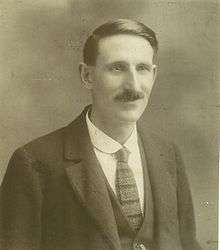Albert J Pitman

Albert John Pitman is regarded by Campanologists as a remarkable and versatile composer, 'perhaps the greatest of all time'.[1] The subject of a biography fairly entitled An Unassuming Genius[2] he was an extraordinary talent in the field of peal composition.
Born in Bridgend, Glamorgan in 1887, two years later he moved with his family some twenty miles west, to Baglan, Neath Port Talbot. He had very little education, leaving school at the age of twelve, but with his teacher telling him ‘there’s nothing more I can teach you.’[3] This was perhaps an early sign of an unusual talent. In 1903 at the age of sixteen he joined the Great Western Railway Company and worked for them until his compulsory retirement at sixty-five.
He learned to ring bells the year he left school, probably from his father, who was a member of the bell-ringing band at St Catharine's Church, Baglan. Only eleven years later, in 1910, he rang AND conducted his own peal, of 5040 Grandsire Triples at St Mary’s Church, Aberavon, 'a highly unusual step for a ‘first-timer.’[4]
Later, his daughter Dolly, who, with her siblings, inherited his mathematical genius, was paid a silver threepenny piece to check his compositions for ‘falseness'[5] None was found to be so then, nor since. Many of his compositions appeared to have been inspired by challenges thrown down by editorials, letters and articles in The Ringing World. The first peal containing more than one Triples of Method ringing was composed, and conducted by him, in 1925. Four years later he composed and conducted the first peal of Forward Major. One of his peals was rung during the celebrations of the silver wedding anniversary King George VI and his queen. He continued to compose throughout the 1940’s a decade capped by him being accorded the unusual privilege of writing the leading article in The Ringing World[6] However, it was during the 1950’s he produced what many regard as his masterpieces, a ground-breaking peal of 5280 Spliced Surprise Major followed by a composition of 5472 or 5408 changes - in The Ringing World it was described as a ‘week of ringing history’[7]
His major achievement in 1961 was the publication of two compositions, numbers 1 and 2 of 13440 Spliced Surprise Major in six methods, another challenge for serious bell-ringers! Less well known, but nonetheless important, are his compositions of ‘Sunday Service’ touches, shorter pieces rung prior to church services, which he continued to produce right up to the year of his death. Throughput his life Pitman was convinced that a major feature of composition was to produce the best music and his compositions have often been regarded as amongst the most musical. Indeed the issue of the musical nature of bell ringing was raised by a leader in The Times on the 1st of February 1927[8]
Albert John Pitman died on August 16, 1966 and was buried at St Catharine’s Church, Baglan, in the grave occupied by his late wife, Evelyn, who had died in 1953, and which is but a few steps away from the grave of his parents. Bell-Ringers mark the death of a colleague by ringing a peal or quarter peal, often rung ‘muffled’[9] the first being rung on the day of his funeral at St Catharine’s. On the day, and In the following weeks, memorial peals were rung in Cheshire, Yorkshire, Surrey, Monmouthshire and Westminster.[10]
His legacy is substantial: a current copy of The Ringing World is unlikely not to contain a reference to him;. S4C, the Welsh-language television channel (the equivalent of Channel 4), broadcast a piece on him in their Christmas Eve 1984 documentary on bell-ringing in Wales, Cân y Clychau. The Central Council of Church Bell Ringers[11] estimate the number of his published compositions to be ‘over a hundred’ [12] with many more unpublished, some of which he sent directly to conductors he felt could ‘do justice’ to the piece. His name lives on in Wales through a striking competition for the Pitman Trophy. His legacy lives on too in the fact that his compositions are regularly rung throughout the now-global bell-ringing world. A search on Bellboard [13] shows compositions of his rung over 600 times in the UK alone since 2000.
To mark the 50th anniversary of his funeral, members of the Llandaff and Monmouth DACBR[14] [15]rang his composition of Grandsire Doubles,[16] as was rung on the same bells at St Catharine's Church, Baglan, immediately after his funeral. Prior to the peal, prayers were said at the graveside, followed by a ringing of hand-bells. Happily, this was all in the company of many of his grand-children, great grand-children and great-great grand-children.
References
- ↑ Davies, Michael B (2007). An Unassuming Genius. The Central Council of Church Bell Ringers. p. 146. ISBN 0-900271-88-4.
- ↑ Davies, Michael B (2007). An Unassuming Genius. The Central Council of Church Bell Ringers. ISBN 0-900271-88-4.
- ↑ An Unassuming Genius. p. 7.
- ↑ An Unassuming Genius. p. 20.
- ↑ Falseness means not repeating any of the rows of figures in the peal.
- ↑ The Ringing World - Spliced Surprise Major, A J Pitman, 4 March 1949 p89
- ↑ "Belfry gossip". The Ringing World p728. 18 November 1955.
- ↑ An Unassuming Genius p49
- ↑ Muffled - muffles are leather pouches which are strapped to one side of the clapper of each bell, so that when that side of the clapper strikes the bell, the sound is muffled.
- ↑ An Unassuming Genius - p151
- ↑ "cccbr".
- ↑ email from Alan Glover, CCCBR Librarian 29-07-2016
- ↑ "Bellboard". Retrieved 22 August 2016.
- ↑ "Llandaff & Monmouth DACBR". Retrieved 10 August 2016.
- ↑ "Llandaff & Monmouth DACBR peal report". Retrieved 23 August 2016.
- ↑ "Bellboard, The Ringing World".